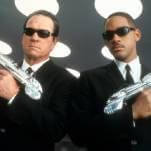Pinocchio

An unintended gift to midnight-movie programmers and students of the bizarre, Roberto Benigni's Pinocchio could have become a Howard The Duck- or Battlefield Earth-like synonym for cinematic miscalculation, were its title not already so familiar. Benigni directed, co-wrote, and stars in the film, which no doubt cost him several opportunities to co-star in Martin Lawrence mismatched-buddy-cop movies; his follow-up to Life Is Beautiful makes good on his decades-spanning wish to bring Carlo Collodi's 1883 children's book to the big screen. Originally planned as a collaboration with Federico Fellini, Pinocchio bears the stamp of Fellini's carnival influence almost as strongly as it shows the stamp of Benigni, whose love for the material and desire to do right by it is evident in every shot. Sadly, watching it is like watching someone try to sculpt a masterpiece out of Silly Putty. Originally planned as a high-profile holiday release complete with a fast-food tie-in, Pinocchio came out quietly on Christmas Day in a chopped-down version, with every voice, including Benigni's, overdubbed by English-speaking actors. That change proves so intrusive and so badly implemented that it never ceases to be a distraction, particularly considering that lunatic integrity is the best the film has going for it. Still boyish at 50 but clearly well into middle age, Benigni plays the eponymous puppet as a candy-powered whirling dervish, as if constant motion could compensate for the passing of time and the decision to forego even a hint of makeup. Benigni seems less like a puppet who wants to become a boy than a mental patient who wants to become a puppet. In an avant-garde children's theater, the decision might have worked, along with the bizarre parade of half-animals that make up the bulk of the supporting cast (not to mention the casting of Benigni's real-life romantic partner Nicoletta Braschi as Pinocchio's maternal Blue Fairy). But joined to the elaborate 19th-century sets, Dante Spinotti's autumnal cinematography, and a film score in the classic Italian mode by Nicola Piovani, it all looks jarringly out of place, like a Raphael fresco in which all the faces have been repainted by Mad cartoonist Don Martin. As for younger viewers, maybe kids in Italy (where Pinocchio became a hit) have different tastes, but the film rolls along almost as if it were designed to creep out easily spooked children. If they aren't scared off by the black rabbits who bear a coffin to Benigni's deathbed, or the extended sequence in which bandits hang an apparently lifeless Benigni from a tree, then the horror of donkey transformation should do the trick. If nothing else, Pinocchio effectively creates a nonsensical world in which the slightest misstep leads to grave consequences. But who needs to pay for such nightmares when the free ones come with better dubbing and even scarier clowns?








































